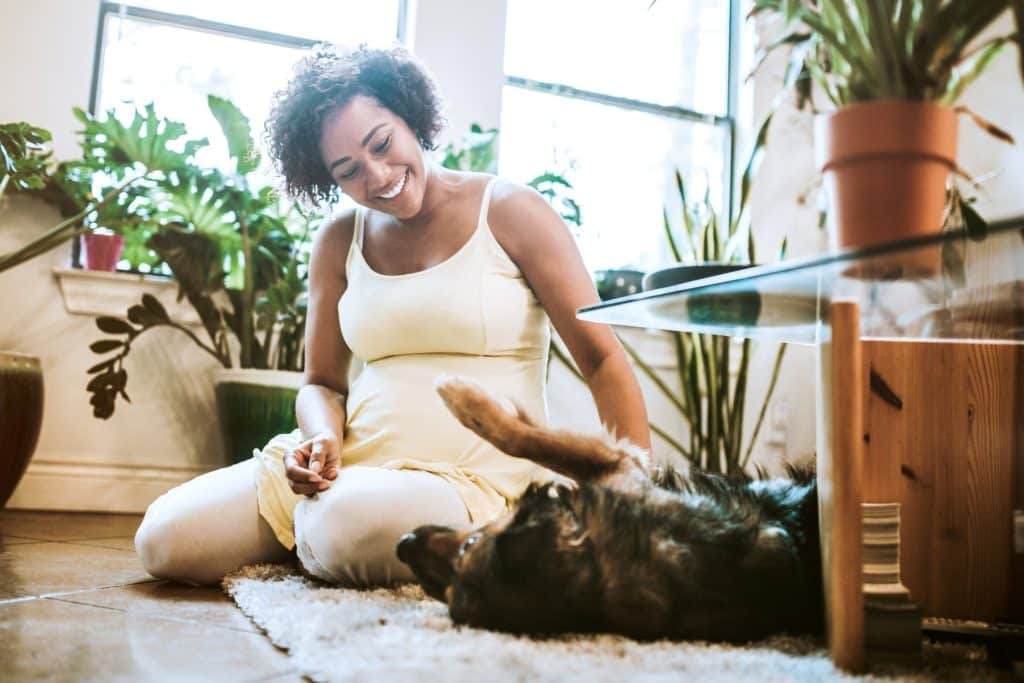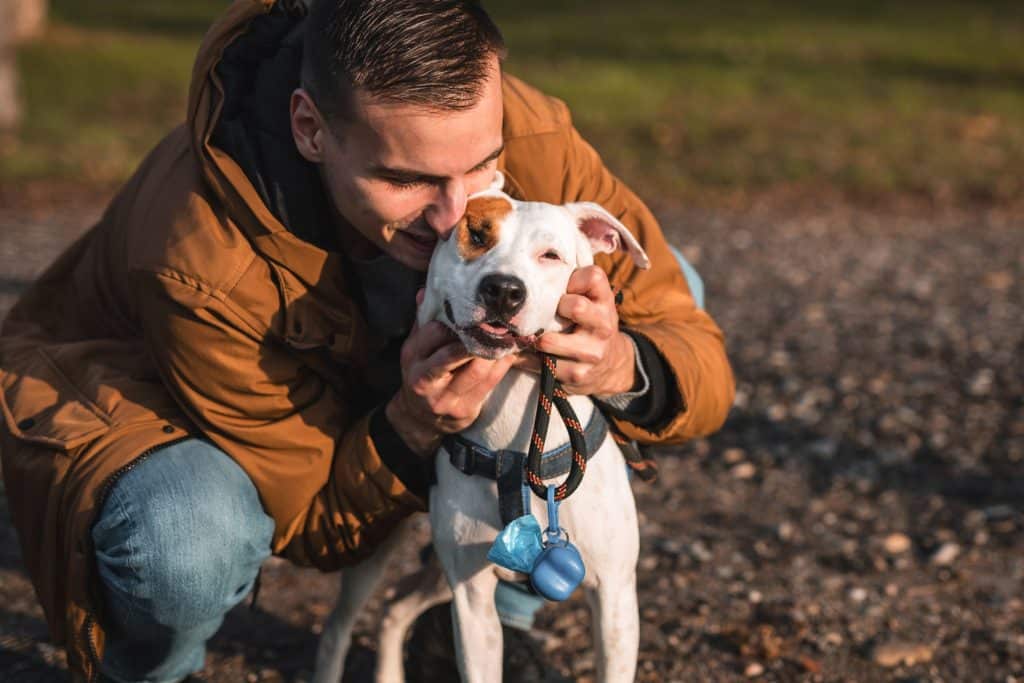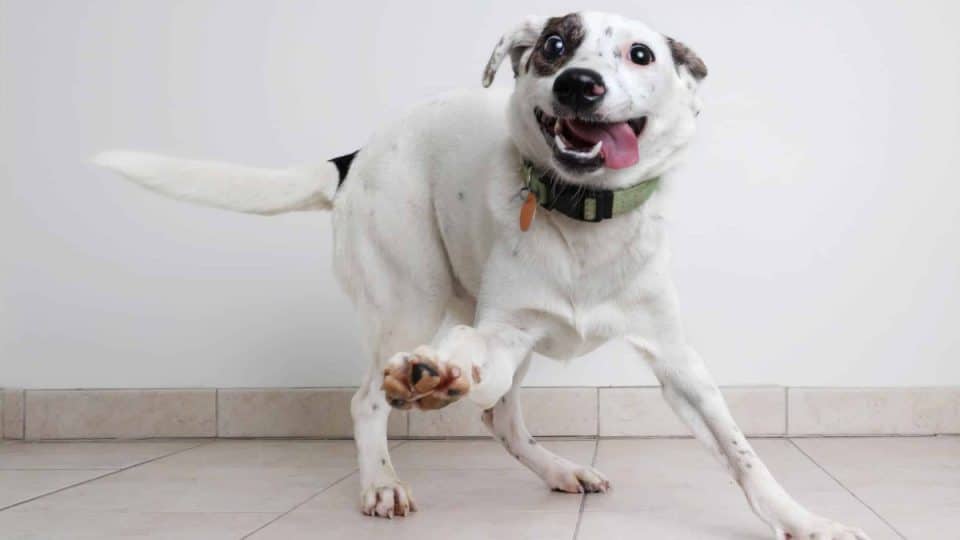- Not a substitute for professional veterinary help.
If your dog is running in circles at top speed, it usually means they have their witching hour. These are bursts of speed triggered by a need for a release of pent-up energy. Common causes are seeing a doggy friend, getting a bath, or going out to the park.
Dr. Jessica Taylor, a veterinarian with Petfolk, says that zoomies are often triggered by some excitement in the environment. That might be you coming home from work, your dog opening a new toy, or a fellow pet getting excited.
While these moments tend to come on quickly, there are signs indicating one is about to begin. “Usually, a play bow will kick things into high gear,” explains Leigh Siegfried, CEO at Opportunity Barks Dog Training. “This is a social invitation to play, which then can kick things off.”
This kind behaviour typically involves a pup running around very fast in a big circle, generally in a lower-down position, or rolling and jumping, reveals Dr. Taylor. “They usually last anywhere from a few seconds to a few minutes,” she adds.
In this article, we’ll explore causes of dog zoomies, whether they’re “normal,” and how to keep your dog safe during one.
Why Do Dogs Get The Zoomies?
They need more exercise
The level of exercise required by a dog varies depending on age and breed. If your dog doesn’t get enough exercise, the witching hour is a quick and easy way for them to expel pent-up energy.
Renee Rhoades, Head Behavior Consultant at R+Dogs, says that ensuring your dog gets some form of physical stimulation during the day can help temper the intensity of the witching hour. These activities include a sniff-focused walk, trick training, or play, like a game of tug.
It’s playtime
“This is related to a dog wanting to play can sometimes be the easiest to spot,” she says. “Usually, the dog will engage with us at some point during this mad half-hour, either jumping up on us, barking, or maybe grabbing at our clothing or hands.”
Ready to play, too? Great! “One of my favorite sayings to clients is, “If it’s not a problem for you, then it’s not a problem,” she adds.

iStock/Eva Blanco
They’ve had a bath
Your dog might love bath time (or getting wet in general!) — and this sense of joy and excitement can prompt this behaviour. However, there’s another reason your pup might start acting crazy after a bath.
“Dogs go into zoomie mode when they are wet in an attempt to dry off,” Siegfried says. The feeling of having a heavy coat isn’t pleasant. Dogs run and roll to shake off water. Have a towel ready to help remove excess moisture.
Stress or anxiety
On many occasions, the witching hour is a happy behaviour — but there are times when they can indicate your pup isn’t feeling so great, Rhoades says. She explains that the witching hour can also occur in response to fear, anxiety, or stress.
So how can you differentiate between a happy zoomie and a stressed-out one? “This can be a bit more challenging,” she laments. “The communication the dog gives through their body movements and subtle signs will give the best estimation of their feelings.”
There are many indicators that a dog is unhappy, including lethargy, disinterest in everyday activities, aggression, hiding, and disinterest in exercise or play. So if they’re running around in a circle and showing these signs, it’s “always good to proceed with the understanding that the dog is either conflicted or uncomfortable,” Rhoades says.
In these instances, she adds, the best thing a pet parent can do is back away, respect their dog’s space, and create distance to de-escalate the situation and help reduce their dog’s stress levels.
Time of day, especially at night
Just because you’re ready for sleep doesn’t mean your dog is. If your dog is running around in circles at night, they likely have a case of the zoomies.
“Although dogs have largely adopted our sleeping patterns, they are innately a crepuscular species,” Rhoades shares. “This means they’re most active during twilight hours, and this is when we are most likely to see the witching hour, too!”
While you can’t change their internal clocks, ensuring they get lots of exercise during the day can help ensure they’re tired by bedtime.
Age
While people often assume zoomies are related to young dogs specifically, Rhoades says older dogs can act out too! Siegfried agrees that age isn’t necessarily a key indicator of zoomie activity. “I’d say it’s [more] about breed traits, play, and then the [specific] situation.”
While older dogs can get the zoomies, they more frequently occur in younger pups — often as part of their ‘witching hour,’ she notes. According to the National Canine Research Association of America, the witching hour is when your pup acts a bit wild and typically occurs early in the morning or between 5-8 pm.

iStock/RyanJLane
They’re happy and excited
Have you ever been so excited you felt like you could burst? The same can happen to our dogs. Zoomies are a playful way for dogs to happily release all that built-up tension.
“Arousal related to positive events, such as a favorite human guest or arriving at a fun outdoor space, are perfect setups for zoomies, especially if they coincide with a lack of other physical or mental stimulation during the day,” Rhoades shares.
While it’s fantastic to know your dog is happy to see you, she says it’s important to bear in mind any safety-related issues — especially if you have a larger dog, like a Great Dane, or there are children around.
“I prefer setting up a protocol for when guests arrive, such as being on a leash or scattering food on the floor to help manage or redirect the dog,” she suggests.
They’ve overtired
You may notice a dog getting zoomies and running around in circles after a walk, which could signal over tiredness. Little kids can quickly get hyper and start running around when it’s past their bedtime, and they get overtired. Young dogs are no different. Overtired zoomies are “more typical in puppies under six months of age,” Siegfried notes.
In these instances, getting them more excited in an attempt to tire them out isn’t the best action plan. Instead, take steps to help calm them and prepare them for bed.
They’re avoiding you
Sometimes your dog running in circles can be their way of avoiding you. It might be part of a fun game of zoomie tag, or it might be a stress response. In stress zoomies, behaviors used as defense or protection can be mistaken for more playful zoomies. For instance, “you go to touch them, and they avoid you or get defensive to create more space,” Siegfried shares.
In these cases, understanding how your dog feels is vital. So, rather than trying to play, take a moment to read their body language cues and recognise if anything is happening that could make them feel stressed or anxious.
Especially if you’re a new dog pet parent, the first time you see your canine engage in the witching hour might be a bit of a funny surprise — but there’s nothing to worry about. “It is perfectly normal for dogs,” states Rhoades.
The scientific term for that is ‘frenetic random activity periods’ (FRAP). Dr. Taylor says that, generally, zoomies are dogs playing and blowing off excess energy.
Zoomies come in all shapes and forms, with some related actions more acceptable than others. Dr. Taylor notes that while zoomies are usually a good thing, you should closely monitor your dog. For example, if your dog engages in the following negative behaviors during a zoomie session, they might need additional dog training.
- Biting
- Knocking things over
- Chasing other dogs and ignoring your cues to stop
- Chasing other dogs and not reading their signals to stop
- Jumping on people
- Chasing tails
Should You Stop Your Dog?
Siegfried explains, it’s about training your dog so you can ensure their behaviour doesn’t get out of hand.
For example, she recommends having your dog come when called in low-distraction and high-distraction settings. This will make it “an accessible behavior when a dog is playing, and you may need to interrupt play.”
Working on ways to indicate to your dog that play is ending is another key approach, Siegfried states. “The repetitive pairing of ‘enough’ at the end of a play session can often signal ‘we’re done.’ But, again, the repetitions need to be established for that to be meaningful for the dog.”
If your dog has finished its witching hour but is still excited, “try scattering some food on the ground for them to find,” Rhoades suggests. “Simple nose work activities like this can help calm dogs.”
How To Keep Your Dog Safe During Zoomies
As Taylor notes, when it comes to zoomies, “the most important thing is that your pet and family are safe.” So what can you do to help prevent hyper dogs from injuring themselves as they run and roll around? Here are some suggestions:
- Check your outdoor surroundings. Rhoades says that trees, holes, or uneven ground can harm your dog when they’re moving quickly. Keep your dog on a leash to help prevent your dog from zooming off and injuring themselves.
- Work on recall. As noted earlier by Seigfried, working on recall techniques with your dog can aid in managing their behaviour.
- Dog-proof your home. Make sure sharp corners and edges are covered and don’t have any rugs or loose carpets your dog could trip on.
- Move them to a safe space. If a zoomie kicks off indoors on slippery floors, Rhoades recommends moving them to somewhere with carpeted floors to give the dog secure footing. She says taking them outside is even better to prevent them from running into furniture or walls.
- Get into a regular exercise routine. Schedule regular exercise with your dog so they can release their energy that way instead.

iStock/chabybucko
What If It’s Not the Witching Hour?
If your dog is running in circles, other factors might be at work. “Spinning,” for example, occurs when a dog runs or turns in tight circles repeatedly. Regular, compulsive spinning can indicate a neurological issue, and it’s a good idea to make an appointment with your vet.
Spinning in circles can also be a stress response. It’s seen particularly in dogs who crew up in crowded or cramped conditions like a puppy mill.
Some breeds are prone to running in small circles as a form of self-expression. Pomeranians and Shiba Inus are especially famous circlers. If your vet gives you the all clear, feel free to sit back and enjoy your goofy friend’s circle runs in peace.
Takeaway
Zoomies are normal dog behavior and can occur in all ages and breeds. Zoomies can signal your dog needs to get energy out or is happy because they were fulfilled in a certain way.
“Giving dogs opportunities to ‘dog’ and rehearse species-specific behaviors will help many dogs be more fulfilled day in and day out!” Seigfried shares.
However, there are instances when zoomies aren’t great, especially if they’re biting you. “If you’re concerned about your dog’s zoomies, reach out to a qualified, ethical dog behavior consultant for guidance and support,” Rhoades concludes.
And since zoomies can be hard to capture or display in real time, you may want to consult an online dog trainer about this behavior. Online dog training allows for you to record the moment and share it with your trainer for the most authentic perspective.
In most instances, however, zoomies allow your dog to release pent-up energy or express happiness, excitement, or love. Having fun and trying new activities with your dog is a great way to help them shake off excess energy. If you’ve done the training and walking and your dog still runs like a hurricane, know that they are most likely feeling more fulfilled. All thanks to you!



